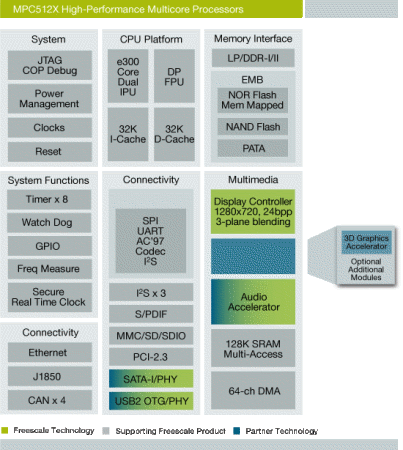Telematics SoC to sample with Linux
May 21, 2007 — by LinuxDevices Staff — from the LinuxDevices Archive — 23 views Freescale is readying a new high-end model in its “MobileGT” family of Linux-friendly telematics SoCs (system-on-chip processors). The MPC5121e is built on 90nm CMOS technology for low power consumption, and integrates a 400MHz PowerPC, 2D/3D graphics core, and programmable media-processing core optimized for real-time… audio functions.
Freescale is readying a new high-end model in its “MobileGT” family of Linux-friendly telematics SoCs (system-on-chip processors). The MPC5121e is built on 90nm CMOS technology for low power consumption, and integrates a 400MHz PowerPC, 2D/3D graphics core, and programmable media-processing core optimized for real-time… audio functions.
Freescale says the MPC5121e's compliance with AEC-Q100 and TS14969 requirements for harsh environmental conditions makes it ideal for telematics, connectivity, and “driver-interactive” vehicle applications such as center console devices. With standard PC interfaces like SATA, USB, and Ethernet, the chip could also be used in general embedded applications, such as networked industrial control, and security/surveillance, networked patient monitoring, gaming, media gateways, and set-top boxes, according to the company.
The MPC5121e is based on an e300 core clocked up to 400MHz. The chip integrates an XGA (1024 x 768) LCD controller, along with a PowerVR MBX Lite 2D/3D graphics core from Imagination Technologies. Additionally, a “fully programmable” 32-bit RISC-based multimedia acceleration core is said to accelerate the decompression of popular audio formats, including MP3, AAC, WMA, and Ogg Vorbis, and to support key features for speech recognition and in-vehicle hands-free applications based on Bluetooth, including sample rate conversion, noise reduction, and acoustic echo cancellation.

MPC5121e function block diagram
(Click to enlarge)
Other touted MPC5121e features include:
- e300 core
- Built on Power architecture technology
- 32 KB instruction cache and 32 KB data cache
- Double precision floating point unit and dual integer units
- Up to 400MHz performance delivering 760 MIPS
- Built on Power architecture technology
- User-programmable 32-bit RISC multimedia core operating at up to 200 MHz
- 2D/3D graphics core based on PowerVR MBX/VGP Lite
- Integrated display controller supporting up to 1024 x 768 XGA resolution
- 12 programmable serial controllers supporting UART, SPI, AC97, I2S
- SDRAM DDR-I/DDR-II/mobileDDR memory controller
- 10/100 Fast Ethernet media access controller (MAC)
- Three I2C interfaces
- PCI 2.3 interface
- Dual USB 2.0 On-the-Go (OTG) controller with an integrated high-speed PHY
- Serial advanced technology attachment (SATA) controller
- Parallel advanced technology attachment (PATA) controller
- Four CAN 2.0A/B modules
- 64-channel intelligent DMA I/O controller
- Sony/Phillips digital interface format (S/PDIF) serial audio interface
- Secure digital host controller (SDHC) supporting MMC/SD/SDIO protocols
- 27×27 mm 516-pin PBGA package (1mm pitch)
Freescale said it will offer a Linux BSP (board support package) for the MPC5121e's development platform, when it begins sampling, and will support the platform under its CodeWarrior Development Studio, MobileGT processor edition. Other tools, operating systems, drivers, middleware, and applications are expected to be available concurrent with sample availability from Freescale's MobileGT ecosystem partners, which include Linux supplier Wind River, as well as RTOS (real-time operating system) suppliers QNX and Green Hills Software.
The MPC5121e is said to offer application code compatibility with earlier Freescale SoCs based on the MPC5200 architecture. Freescale (then Metrowerks) launched its Automotive Grade Linux stack for 5200-series SoCs in October of 2004.
Mike McCourt, Freescale GM of microcontrollers, stated, “The MPC5121e is Freescale's most powerful, feature-rich processor for telematics applications. This processor [is] ideal for next-generation applications that require sophisticated displays, graphics/multimedia acceleration, network connectivity, and mass storage.”
Availability
Samples of the MPC5121e processor are planned to be available in the late second quarter. A version without the 2D/3D graphics core is also planned for later delivery.
This article was originally published on LinuxDevices.com and has been donated to the open source community by QuinStreet Inc. Please visit LinuxToday.com for up-to-date news and articles about Linux and open source.